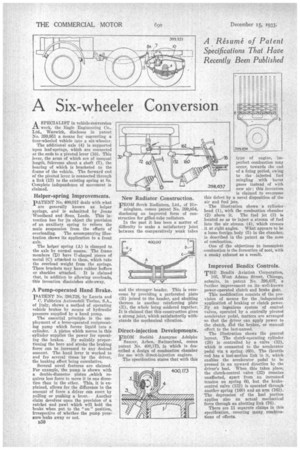A Six-wheeler Conversion
Page 68

If you've noticed an error in this article please click here to report it so we can fix it.
A Résumé of Patent Specifications That Have Recently Been Published
ASPECIALIST in vehicle-conversion work, the Eagle Engineering Co., Ltd., Warwick, discloses in patent No. 399,951 a means for converting a four-wheeled vehicle into a six-wheeler.
The additional axle (4) is supported upon leaf-springs, which are connected at the ends to a pivoted lever (10). This lever, the arms of which are of unequal length, fulcrums about a shaft (7), the bearing of which is bracketed to the frame of the vehicle. The forward end of the pivoted lever is connected through a link (13) to the existing spring at 8a. Complete independence of movement is claimed.
Helper-spring Improvements.
pATENT No. 400,017 deals with what
are generally known as helper springs, and is submitted by Jonas Woodhead and Sons, Leeds. This invention has for its object the provision of an auxiliary spring to relieve the main suspension from the effects of overloading. The accompanying illustration shows its application to a front axle.
The helper spring (A) is clamped to the axle by uormal means. The frame members (1)) have 7J-shaped pieces of metal (0) attached to them, which take the overload weight from the springs. These brackets may have rubber buffers or shackles attached. It is claimed that, in addition to allowing overloads, this invention diminishes side-sway.
A Pump-operated Hand Brake.
FATIENT No. 398,728, by Lancia and C. Fabbrica Automobili Torino, S.A., of Italy, shows a method of operating vehicle brakes by means of hydraulic pressure supplied by a hand pump.
The essential principle is the employment of a lever-operated reciprocating pump which forces liquid into a cylinder. A. piston which moves in this cylinder supplies the power for operat
ing the brakes. By suitably proportioning the bore and stroke the braking force can be increased to any desired amount. The hand lever is worked to and fro several times by the driver, the braking effect being cumulative.
Several novel features are claimed. For example, the pump is shown with a double-diameter piston ,which requires less force to move it in one direction than in the other. This, it is explained, allows for the difference in the amount of force a driver can exert by
pulling or pushing a lever. Another claim devolves upon the provision of a ratchet -and pawl which will hold the brake when put to the "on" position, Irrespective of whether the pump pressure leaks away or not.
)350
FROM Serck Radiators, Ltd., of Birmingham, comes patent No. 399,854, disclosing an improved form of construction for gilled-tube radiators.
In the past it has been a matter of difficulty to make a satisfactory joint between the comparatively weak tubes and the stronger header. This is °vetcome by providing a perforated plate (B) joined to the header, and abutting thereon is another reinforcing plate • (E), the whole being soldered together. It is claimed that this construction gives a strong joint, which satisfactorily withstands the mechanical vibration.
Direct-injection Developments.
FROM SocietO Anonyme .Adolphe Sauter, Arbon, Switzerland, comes patent No. 400,173, in which is described a design of combustion chamber for use with direct-injection engines.
The specification states that with this type of engine, imperfect combustion may occur, towards the end of a firing period, owing to the injected . fuel mingling with burnt gases instead of with new air ; this invention is claimed to overcome this defect by a novel disposition of the air and fuel jets.
The illustration shows a cylinder head, (1), with the combustion chamber (2) above it. The fuel jet (3) is located so as to inject a stream of fuel into the air stream (4), which crosses it at right angles. What appears to be a loose foreign body (5) in the chamber, is described in the patent as the zone of combustion.
One of the objections to incomplete combustion is the formation a soot, with a smoky exhaust as a result.
Improved Bendix Controls.
TEE Bendix Aviation Corporation, 105. West Adams Street, Chicago, submitsr in patent No. 398,637, a further improvement on its well-known power-operated clutch and brake dear.
This modification consists of the provision of means for the ,independent applicatioe of braking or clutch power. By an ingenious system of control valves, operated by a centrally pivoted accelerator pedal, matters are arranged so that the driver can apply power to the clutch, iiind the brakes, or manual effort to the last-named.
The illustration shows the general layout. The clutch-operating cylinder (28) is controlled by a valve (32), which is connected to the accelerator pedal via a spring (60). The throttle rod has a lost-motion link in it, which enables the accelerator pedal to be pressed in an upward direction by the driver's heel. When this takes place, the dutch-control valve (32) remains unaffected, apart from an increased tension on spring GO, but the brakecontrol valve (132) is operated through another spring (160) and an arm (162). The depression of the heel portion applies also an actual mechanical force through an abutting link (76). There are 11 separate claims in this specification, covering many combinations of effects.




































































































